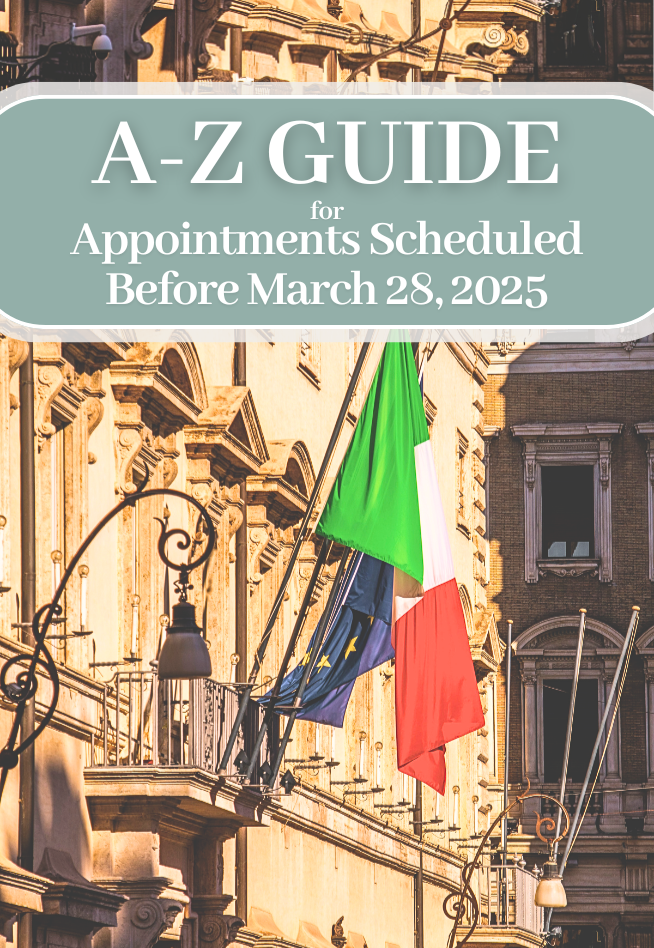This A-Z guide serves to inform on the eligibility and application process for Italian citizenship by descent for those who booked an appointment with an Italian municipality or consulate before March 28, 2025 ( “old rules”).
Prior to legislation effective as of May 24, 2025 (Law No. 74/2025), there was no generational limit to claim Italian citizenship by descent, as long as an unbroken chain of citizenship was proven to the most recent Italian-born ancestor, who must have been alive in 1861 (when Italy became a unified nation). If you submitted your citizenship application prior to March 27, 2025 or were notified of a booked appointment before March 27, 2025, your application will be processed pursuant to the rules in effect prior to May 24th. Note: these rules also apply to cases filed in an Italian court prior to March 28, 2025.
Background:
Jure Sanguinis – “Right of Blood”
Latin A principle of nationality law by which citizenship is determined by having one or both parents who are citizens of the state.

Jure Sanguinis is a very important term to know when talking about Italian citizenship by descent. Jure Sanuinis is a large part of the basis for the laws governing Italian nationality. The laws of Italy in their current form are quite liberal, allowing individuals of Italian descent to claim Italian citizenship from an Italian ancestor as long as citizenship was transmitted from one generation to the next without being interrupted. Jure Sanguinis grants the ability for those from the Italian diaspora to be fully recognized as Italian citizens regardless of their place of birth, as long as this person is able to meet certain basic criteria and document their lineage, thus leaving the doors wide open for people of Italian descent to return “home”.
Introduction:
Italian dual citizenship is a subject which has become more and more spoken about. People from across the globe are finding out that it is possible to become an Italian citizen and to have dual citizenship. Many are interested in this opportunity and are taking advantage of actually going through the Jure Sanuinis process themselves. The laws that govern Italian citizenship and allow a person of Italian descent to be recognized as a citizen are not anything new and have existed in some form or another for over a century, although over time there have been updates to make it more accessible. In this modern world that we live in, where people are so interconnected and mobile, it is much easier to move around the globe than it was when many of our ancestors left Italy. All of these factors together have made it much easier to apply for Italian citizenship and to have the ability to transfer it to future generations who will have the opportunity to go back to their homeland without restrictions and enjoy the benefits associated with Italian citizenship.

There are many benefits to Italian dual citizenship which we have covered in this post.
This guide will cover the various steps and points of interest to consider when applying for citizenship and also review the various topics related to Italian citizenship, e.g. what is Italian citizenship, how does a person qualify, the where, when and how; an A-Z guide taking you through all of the steps from day 1, all the way until the very end when you receive your passport in your hand.
We will start with the basics of how a person inherits Italian citizenship. Many countries around the world (such as the USA) have a system in place where a person automatically gains citizenship to that nation simply by being born on the territory of that nation. This principle is called Jus Soli which means “right of soil”, more commonly referred to as birthright citizenship. The Italian system does not take this into account except in some rare cases. Although, in the context of this guide, because Jus Soli is not directly related to the process of acquisition of citizenship by descent, this guide will not be covering these uncommon circumstances. Italy’s nationality law is largely based on what is called Jure Sanuinis, by “right of blood”, also referred to as citizenship by descent. This means that a person would be able to have Italian citizenship simply by being born to an Italian parent, regardless of the location of the birth and regardless if that parent was aware of their citizenship status. Italian citizenship is automatically passed to the child of an Italian citizen and continues to do so without generational limits as long as the line of citizenship has not been “broken”. Many countries around the world also base their citizenship on Jure Sanuinis as part of their system but some mix between Jure Sanuinis and Jus Soli. To use the example of the US, their system takes into account primarily Jus Soli whereas Jure Sanuinis is applied in special circumstances.
One of the reasons why Italian citizenship laws have been so open is because years ago a large percentage of its population had been leaving the country due to difficult economic situations, natural disasters, earthquakes, droughts and famines leading many Italians of that era to search for work in other parts of the world. Many of those who left never intended to leave Italy permanently, but unfortunately, due to the circumstances of that time, were unable to return to Italy. A large number of these people spent the rest of their lives working hard to give their families what they weren’t able to give them in Italy during that difficult period. Now, many years and generations have passed. The Italian government realized that by allowing those people who had left and their descendants the opportunity to return and be recognized by Italian law as citizens, they might choose to return. This would allow these descendants and their descendants to be able to reconnect with their home country and potentially return “home” to start or continue their lives in Italy.
An important point to keep in mind in regards to Italian citizenship via Jure Sanuinis, is that people who are entitled to Italian citizenship by descent are not required to relocate or reside in Italy at any time in order to gain recognition of Italian citizenship.
DETERMINING ELIGIBLITY
Some important dates to consider

As mentioned in the last section, Italian citizenship can be passed along from generation to generation without any limits to the generation gap between the Italian-born ancestor to the applicant. The only caveat is that the Italian born ancestor must have been born or still living on or after March 17th, 1861, which is the date of the foundation of the modern nation as we know it today (with the exception of few pre-unitary states that became part of the Italian nation at a later date).
Before the unification of Italy, the country was made up of many individual states that were separate and in some cases even warring with one and other. Once the unification came into existence, this was no longer the case and the Italian people were unified under one banner. Due to this, if a person died before unification, that person would have never technically been a citizen of Italy, and therefore disqualifying a potential applicant from being recognized as a citizen of Italy.
This leads into another caveat… your ancestor must have still been a citizen of Italy and did not renounce their citizenship or become naturalized as a citizen of another country (intentionally) before the next generation was born.
In short, eligibility will be determined by whether your ancestor who you would be making a claim under, would have still been recognized as a citizen of Italy at the time of their child’s birth in a foreign country. If your Italian-born ancestor was naturalized before the next person in your family line was born, you would not be eligible to claim Italian citizenship through that ancestor through Jure Sanuinis.
As per “circolare” n. 43347, released on October 3, 2024 by the Ministry of the Interior in regard to rulings by the Italian Supreme Court (Corte di Cassazione), a new interpretation of the Italian citizenship law will be applied going forward to citizenship by descent applications at Italian consulates worldwide and all Italian municipalities. If the Italian-born ancestor voluntarily acquired foreign citizenship while their child was still a minor (before March 9, 1975, the age of majority was 21 in Italy), the minor lost his or her Italian citizenship automatically. Therefore, this would have interrupted the chain of citizenship leading to the applicant, making them ineligible to apply through this Italian ancestor at an Italian consulate or Italian municipality. Those falling into this category of a “minor age” case have the possibility of filing their claim via the Italian courts due to extended wait times to secure an appointment at their local Italian consulate. Italian courts are not bound by the above-mentioned guidelines and are currently approving the majority of cases involving an ancestor who has naturalized when their child was a minor. NOTE: Alternatively, it’s possible to apply via the courts through a female Italian-born ancestor who never naturalized, naturalized when their child was an adult, or naturalized involuntarily. This directive does not affect those who have already had their Italian citizenship recognized.
The second important date that a person should take into account is July 1, 1912, which is when law 555/1912 regarding citizenship was put into effect. This law includes provisions which are for the most part still in effect today. Any ancestors who became naturalized before July 1, 1912 would be unable to transmit citizenship to the next generation, even to children born before that person’s naturalization. This is because the line of citizenship would have been broken.

Please note that, in most cases, people who emigrated to the US as minors became US citizens when their parents naturalized. People who obtained US citizenship derivatively from their parents received a US Certificate of Citizenship (rather that a Certificate of Naturalization); such certificates can be easily recognized from the letter “A” written before the certificate number.
Citizenship certificates marked with “AA” (double A), on the other hand, were issued to children born abroad to US citizens. Although rare, there were in fact cases of Italian men who emigrated to the US before marriage, obtained US citizenship, then returned to their hometown in Italy to get married, have children and finally migrate back to the US with their newly formed family. Their children, although born in Italy, would be recognized as US citizens at birth and given a “special” Certificate of Citizenship as proof of their status.
Although, not all minor immigrants obtained derivative citizenship from their parents.
In some cases, people who entered the country as minors became of legal age before their parents were able to complete the naturalization process. In this case, the child would not have been included in the parents’ papers and would have had to file a separate Petition for naturalization once they became of age.
Some other dates to take into consideration are December 31, 1947 and January 1st ,1948. January 1st, 1948, is when the Italian constitution as we know it today, came into effect. This is also the date that women gained the same rights as men in regards to allow them to pass down citizenship to future generations as well as some other civil rights such as the ability to vote. These dates would be of significance to a person whose ancestor is a female who gave birth to the next person in their family line on or before December 31, 1947. If your ancestor was born to a female Italian citizen on or before December 31st, 1947, it would then be necessary to go through a judicial process to be granted citizenship. A subject we will cover later in this guide.
Although, if your ancestor was born to a female Italian citizen on or after January 1, 1948, this would allow you to proceed through the administrative process through an Italian consulate or Italian comune (municipality), which we will also cover later in this guide.
An example of a family line that would be able to pursue the administrative Jure Sanuinis process:
– Great-grandfather
Born (in Italy): December 15th, 1892
Married (in Boston): May 26th, 1913
Naturalized as a US citizen: August 19th, 1942
– Grandfather
Born (in Boston): January 10th, 1919
Married: June 16th, 1944
– Mother
Born (in Boston): April 14th, 1947
Married (in San Francisco): March 23rd, 1980
– Applicant A
Born (in Atlanta): September 21st 1988
Even though in this example, the applicant’s mother would have been born before 1948, because she was born to a male citizen, he was able to pass citizenship down to his daughter without question.
An example of a family line that would be able to pursue the judicial ”1948” process:
– Great-grandfather
Born (in Italy): December 15th, 1892
Married: May 26th, 1913
Naturalized as a US citizen: August 19th, 1942
– Grandmother
Born: January 10th, 1919
Married: June 16th, 1944
– Father
Born: April 14th, 1947
Married: March 23rd, 1980
– Applicant B
Born: September 21st 1988
In this example, the applicant’s father was born to a female Italian citizen before 1948, therefore, a 1948 court case would be necessary since she did not have the ability at that time to pass citizenship to her son. However, due to modern rulings, this antiquated understanding has been retroactively ruled against, allowing people with this specific family situation to obtain citizenship by petitioning the Italian courts.
If you feel as though you might fall under the situation where it would be necessary to pursue a “1948 court case” please feel free to contact us for a free evaluation of your case and, for more information about the judicial process, click here.
There is one more date that can be important to take into account. The final date to consider is August 15, 1992. This is the date the current citizenship law came into effect. This law overthrew the concept of “unique” citizenship, and finally allowed Italian citizens to hold dual citizenship. As a consequence of this law, any Italian citizen who became naturalized after August 16, 1992, would have retained their Italian nationality even after naturalization. In other words, in this situation where an Italian parent naturalized prior to the child’s birth, but on or after August 15, 1992, the child’s Italian citizenship would not have been compromised.
Gathering Documents
If you have determined that you may be eligible for Italian citizenship, what will confirm your eligibility will depend on various records which will need to be ordered from the country/countries where you and your ancestors have resided outside of Italy. Keep in mind there are document(s) that will also be required to acquire from Italy. Of course, this is a part of the “executive full service package” that we offer to our clients.
To learn more about services click here.
As an example, if your Italian ancestor relocated to the US, and each generation since that time has only lived in the US, then you would need documents from only the US and Italy. If your Italian born ancestor relocated to Argentina, had their child there, then that child relocated to Australia where you were born, you would need documents from Argentina, Australia and Italy.
All major life events in Italy are recorded and transcribed at the municipality where your Italian born ancestor had been living. You will need to make sure you have birth certificates, marriage certificates, death certificates, and naturalization records (if applicable) for each generation going all the way back to your Italian born ancestor. Some consulate may also ask for documents from your “non-direct line” ancestors. If you are applying through your father and grandfather for instance, the consulate may also require to see birth/death certificates for your mother and grandmother.
At your appointment these documents will demonstrate to the Italian government that the chain of Italian citizenship, starting with your last ancestor who lived in Italy down the line to you has been kept intact.
Sometimes, when potential applicants don’t have all the “pieces of the puzzle”, going through their family tree can be a critical step in acquiring these documents. If your family doesn’t already have a genealogical tree, there are many tools available online to help you get started. When going through this process, it is important not to leave any stone unturned. It might just be time to get in contact with that one cousin who you fell out of contact with 30 years ago. Having a clear picture of your lineage, is something that will also help you determine and can confirm whether you are able to proceed and if you can proceed, which route is the appropriate one for you.
Side note: It’s not uncommon for a person to have 2 or more viable family lines going back to Italy. It could be that by choosing one line, it could make it necessary to go through the administrative “traditional” process, while choosing the other would make it necessary to go through the Judicial process. If this is your case, you would need to pursue the administrative process first, and only if your petition is rejected (which is rare) would you then be able to proceed through the judicial process.
An example situation for the documents required for our example applicant from the previous section, “Applicant A”
– Great-grandfather
Italian Birth Certificate from the municipality where he was born.
Marriage certificate from Boston City Hall
Final naturalization papers
death certificate
– Grandfather
Birth Certificate from Lincolnshire County
Marriage Certificate from Boston City Hall
death certificate
– Mother
Birth Certificate from Lincolnshire County
Marriage certificate from San Francisco County Clerk
– Applicant A
Birth Certificate from Fulton County Vital Records Office
Even though in this situation, the applicant’s mother would have been born before 1948, because she was born to a male citizen, he was able to pass citizenship down to his daughter without question at the time.
A few points to take note of:
- Vital records will have to be acquired from different offices depending on the jurisdiction where the event took place. In some locations you may need to acquire the same type of document from the city hall, while in other places you may need to get it from the county clerk and perhaps in another place you must go to the State Vital Records office.
- All vital record documents should be acquired in the longest format available (long-form certified copies). For instance, New York birth records should be obtained in their extended format (“transcripts” are not acceptable), marriage records should also include the marriage license (when available) and so on…
- All documents not in Italian will require translations into Italian.
- When applying in Italy, certified translations will be required.
- When applying in the USA, translations are generally certified by the consulate (there are exceptions to this rule. Some Italian consulates in the US will require certified translations for some or all your documents).
- All non-Italian documents need to be certified copies with an apostille certification attached (we will cover certifications and legalizations in the next section).
- In lieu of a birth certificate for an ancestor who came from Italy and did not have a birth certificate a baptismal record may be accepted. This may also be the same situation for any other direct line relative who was born in a country where they were unable to get a birth certificate.
- Death certificates are also necessary when applicable.
- There is a special situation in New York State pertaining to birth records. If one of your intermediate ascendants (or their spouse when non-in-line relatives’ documents are required) was born in the State of New York and is deceased, these documents require a court order to be able to be released. Although, this does not include birth records registered in the City of New York. If your family member was born in New York City, a court order is not required.
In general many Italian consulates and comuni (Italian municipalities) will not require documents of non-direct line ascendants, although, there are some consulates that do require documents of non-direct line descendants. In this case, it would be necessary to get all of the documents not only from your direct line of ancestors who came from Italy but also birth and death certificates from your ancestors who were married to your direct line ancestors.
Discrepancies

Often (and especially in the case of the ancestors that are further removed), vital records contain discrepancies between the names or dates.
One of the main reasons for this was that many immigrants could not speak English well enough to confirm their details and information was transcribed incorrectly. Furthermore, it was not uncommon for an immigrant to change the spelling and anglicize their name upon arrival in the US, in an attempt to better integrate in their new country.
Discrepancies generally fall into three categories:
1. “Low Impact” Discrepancies
These discrepancies in your documents are generally not an issue and are not an obstacle to the success of your application. In most cases no action needs to be taken.
For example direct translations of names such as Vincenzo/Vincent or Michele/Michael.
2. Minor Discrepancies (Misspellings/Typos)
Minor discrepancies may not be an issue or can be fixed easily through the same governmental offices that issued the inconsistent documents in question. These inconsistencies can include slight variations of last names, parent’s names on birth records that slightly differ from their original version, inconsistent information on death records.
If your ancestor indicated a different date of birth on his naturalization records, when these records show his/her exact place of birth an Italian consulate may accept a document from the Italian municipality stating that there is no other individual born with the same name in the same town in the different date.
3. Major discrepancies.
For any ancestors in your direct family line linking you to Italy who may have unofficially changed their name or last name, you may need to show documentation connecting their birth name to their adopted or chosen name. When such documentation is not available you may need to correct and amend inconsistent records, the complexity of which may vary depending on the specific case.
In the case of major discrepancies that cannot be amended through administrative processes or through court orders you may have to petition the court in the US to obtain a “one and the same court order” in order to have a successful application. If you require assistance with these type of court orders, please contact us.
NOTE: If you have changed your name for other reasons, documentation may also be required. The Italian law generally requires that you amend your birth record. But, if your name cannot be amended on your birth certificate (for example in the case of marriage), your birth name will be the name by which the Italian government will recognize you.
Legalizations

Each document that you acquire that is not from Italy, will require certifications, authentications or legalizations depending on the country of origin. For documents issued in the US, you must obtain what is known as an apostille.
Only certified copies of documents (not genealogical copies or photocopies) can receive apostille stamps.
How you go about getting an apostille depends on the state or country that you are in. If you are in the United States, in general, obtaining an apostille will be through the Secretary of State, yet, in some places it may be through the Treasury Department. In some instances it may be necessary to obtain intermediate authentications before documents can be apostilled (for instance, birth certificates from New York City need to bear a “letter of exemplification” and need to be authenticated by the county clerk’s office before they can be apostilled).
You will need to check what the procedure is in your state. However, if you have elected to use our Executive Full Service package, just like all other steps in the process, we will be able to take care of these matters on your behalf.
Apostilles can only be issued for documents that are from that specific jurisdiction. For instance, if you were born in the state of Georgia but live in the state of Washington, you will need to send your documents to the state of Georgia for certification. They cannot be certified in Washington state.
When requesting documents and certifications from countries other than the United States, you may find that Apostilles aren’t available. Only participating signatory countries to the Hague Convention issue this form of certification. In these cases, often the document can be legalized by the Italian consulate in the country where the document originated, but an intermediate authentication by a central authority in the issuing country may be required. For more information we recommend you contact us or the Italian Embassy in the country in question.
To read more info about the Apostille and what it is click here.
Translations
If you are applying in your country of birth and are a citizen of that country:
Once you have gathered all of your documents and they have been legalized and certified with an apostille stamp, it will then be necessary to translate your documents into Italian. Depending on your consulate, they may or may not accept translations that you have done yourself or through a translator. It is not recommended for persons who don’t have a strong command of the Italian language to translate their own documents as there are unfortunately, many opportunities to mistranslate. It could be a seemingly small term but nevertheless, it could be a world of difference or a nuance that could change the meaning completely. Google translate would never be recommended for this purpose. While it may be possible to translate the documents on your own or through informal translation services, translations are also another service that we, at Italian Citizenship Assistance, include in our assistance packages.
In some limited cases for some or all of your documents a certified translation may be required. Generally this means that an official translator must prepare your translations and swear before a US public notary they are accurate. The notarial certificate should then also be apostilled.
If you are applying in Italy or reside in another country other than the country of your birth:
If you are in a country that has an official language other than the language your documents are written in and they do not recognize the language of the documents you possess as an official language of the country, it may be necessary to acquire certified translations. Often certification of accuracy issued by the Italian consulate in the country where the documents originated is required. If you apply in Italy, the certified translations will need to be certified either by the consulate with jurisdiction over the issued documents or through an Italian court. If you are applying in another country the requirements of the translations may differ depending on the certification process of the country. In some countries, for instance, it is necessary to hire a lawyer to take care of the translations with translation rates set by the local government.
Applying in Italy VS Applying Abroad

Many people choose to make an appointment with the consulate before they even start to gather their documents. This can be a good idea for people in jurisdictions where wait times for initial appointments are long. Unfortunately, lengthy wait times are more of a norm in the US. If you are not sure whether you want to apply in Italy or where you reside, you do have the option to change your mind and you could cancel your appointment if you decide not to work with the consulate for your jurisdiction.
The wait time for an initial appointment can start at 6 months in some consulates and has gone up quite a bit in some jurisdictions around the world. Although, there are a few rare consulates around the world that currently only offer walk in services. For more information on how to make an appointment, the consulate for your jurisdiction should have instructions on how to use their Prenota Online (appointment booking) system.
Keep in mind that when applying in the US it is necessary for a person to apply at the appropriate office and that would be where that person legally resides. For example, if you live in San Rafael, California, you would live under the authority and in the jurisdiction of the consulate in San Francisco and be required to apply there. If you live in Los Angeles, even though they generally have a much longer wait time, and even if you would prefer to apply through a consulate with a shorter wait time for an appointment, you would be required to apply through the Los Angeles consulate and not be allowed to opt for applying someplace else such as San Francisco or even Houston or any other consulate besides the one where you reside.
This is where one of the benefits of applying in Italy becomes quite apparent. When applying at an Italian municipality, it is almost never required to make an appointment ahead of time. For some this is motivation enough to want to apply in Italy. It is possible to go to the comune when you choose with the possible consideration as to their specific hours of operation.
If you are considering living in Italy and you want to apply in Italy, you can do this as long as you become a legal resident of the comune where you will be choosing to apply. It is possible to easily set up residence in Italy in order to go through the Jure Sanuinis process, if you are willing to spend some time in Italy. Again, this is also something we, at ICA, can help facilitate for you.
Nonetheless, when considering whether to apply at an Italian consulate or at an Italian municipality there are many things to take into consideration. Here are just a few:
- convenience
- how realistic is it and financially feasible to spend a significant period of time in Italy?
- which is more practical for your specific situation?
- children – for younger children it may be easier to make a long term transition starting while they are young. This could give them a head start in becoming integrated into Italian society. For teens the adjustment can in some cases be a little bit more difficult. However, if they are already thinking about going to study abroad for university, this can be a great opportunity for them to study in an Italian university for a fraction of the price of studying in the US.
- the possibility to retire in Italy or to start living in Italy right away
And of course, depending on your situation, spending time in Italy may be the appropriate choice for right now but for some it may be the right choice for later in life.
When applying in Italy, the process is generally faster, although, this process very much depends on which municipality where you apply. If you apply through a consulate, the times do vary because it depends on various factors such as the consulate’s processing times and their workload.
When applying in Italy, it is also important to take into consideration your ability to stay there. This is not only from the legal perspective of actually being able to remain in Italy for an extended period but from a practical financial perspective as well. It can be a big commitment.
Some people decide to spend in Italy the time strictly necessary to complete the citizenship application process. Other wish to relocate to Italy on a permanent basis or even for a few years, in which case this option may be a more interesting opportunity for you since it will allow you to start exploring life in Italy much sooner than waiting for an appointment at a consulate outside of Italy.
Although the ability to speak Italian is not a requirement when applying for citizenship by descent, another point to consider when thinking about applying in Italy vs outside of Italy is your linguistic skill level. If you already speak Italian this will be a moot point for you. Whereas, if you do not currently have a sufficient command of the Italian language, applying in Italy may be challenging but not impossible if you plan to do it yourself, without the assistance of a lawyer or a translator. Although, with the proper assistance, this can be much simpler. If you choose to apply in Italy, Italian Citizenship Assistance can assist you throughout the entire process as part of our Full Service Executive packages. ICA will also be able to assist you in setting up your legal residence in Italy which is not only an important step in the process but a required step in order to apply in Italy.
When applying in Italy, there is an application fee, ranging up to 600 euros, depending on the comune, and it may sometimes be required to purchase a 16 Euro marco da bollo (Italian revenue stamp) whereas when applying at an Italian consulate the fee is currently 600 euros but does (with rare exceptions) include the cost of translation certification.
If applying in Italy, you may, however, need to sustain the costs of applying for a residency permit, allowing you to remain in the country for the duration of the process, if this should exceed the 90 days, which is the term of stay generally allowed to tourists entering Italy through the visa waiver program or to tourist visa holders. The cost of the residency permit for dual citizenship purposes is currently +/- €120 per year plus the cost of health insurance which can cost roughly the same if you elect to use the public healthcare system, which has been rated one of the top in the world.
Appointments

The next step, if you have opted to apply at an Italian consulate, will be to determine when you’ll be able to have your appointment. This can be booked through the Prenota Online system. Due to the fact that appointments are in such high demand, it can take awhile for a person to get an appointment and may even take multiple attempts trying to schedule one, again depending on demand at the time.
Unfortunately, many appointments go unattended and there are many people who will “hold” appointments that they never intend to use themselves which sadly causes others to wait. This is an issue the Italian government is currently addressing.
To get the most up to date list of available appointments and which new appointments have been added to the schedule, check the Prenota Online system which is generally updated daily at 12 am Italian time during the business week. If you require assistance in getting an appointment, this is another service that ICA offers as a part of our executive service package.
When you are at your appointment, if you do not speak Italian or if you do not have a strong command of the Italian language, you can speak in the language of the nation you are in. For example, if you are in the USA, you can speak in English. All Italian consular clerks are bilingual and speak both Italian and the language of their host country.
Based on reports from our clients, if you do choose to conduct the conversation at your appointment in Italian, the clerks may understand the importance of your Italian heritage and what the citizenship application means to you. Consulate officials generally appreciate people who chose to conduct their interview in Italian (even if, as we said, it is not a requirement). It is also not uncommon to hear from the clerks the importance of knowing Italian as an Italian citizen. The addition of a “grazie” (thank you) at the end of your interaction of course will never hurt.
If you apply and choose to do-it-yourself, it is recommended to organize your documents in your “citizenship packet” starting from you, (the applicant) or starting from your last Italian born ancestor and proceed through the documentation in chronological order. It will make it much easier not only for you to be able to keep track of but it will be easier for the clerk to understand which documentation you have and which may or may not be necessary. A family tree may also help the clerk better understand your specific situation. For those of you who elect to use our Full Service Executive Package, this is another step that will be taken care of for you.
When it comes time for your appointment, you will present all of the documents that you have to the Italian consulate along with the translations and apostilles. Sometimes when people opt not to work with a service provider, there is the possibility that certain details may be overlooked causing the applicant to be sent home with homework that needs to be completed to be able to continue through the citizenship process. It may be as small as getting a translation of a document or a certification of a document, but other situations could be that an applicant has documents that have names that are mismatched. Then it may be required to clarify and get further proof to shed light on any questions the Italian government may have. We’ve heard a number of stories when people who had chosen the DIY (do it yourself) process and had overlooked a simple detail which created the necessity to start from the beginning. These issues can be completely avoided when working with someone who knows the Italian legal system and has practical experience. When there are name discrepancies, it may be necessary to have amendments made to documents. It is possible to do “assisted DIY” with us at your side, through our services at ICA. We have our Step by Step Package where we can be there to guide you through the process. You can do as much as you are able, but then you can have ICA there to assist you if and when you need.
Side note: If you opt to apply in Italy or a country you are not from, due to a lack of understanding of how some documents and processes work outside of Italy or the nation you are in, there may be requests from Italian clerks for documents or certifications that do not exist in your country, which may be necessary to explain.
If applying in a consulate in the United States, it will also be necessary to bring your local/ state identification and a recent utility bill to clearly show your current residence.
The Italian consulate or comune keeps all of your documents that you submit to them and they are not returned to you. Your records are stored in a file that they will create for you. If these documents are important to you or if you may need these documents for other things, be sure you have extra copies. In the case where you have an older historic document, you may want to acquire a modern certified copy of that document so you can keep the original. Many people prefer to keep the original documents that may be 100 years old or more in their family albums for sentimental reasons. In some cases that is a necessity as older documents may no longer be apostilled or otherwise legalized. Acquiring a modern copy is generally pretty straightforward for those documents in the US. It is also not a difficult task to accomplish in Italy for someone who speaks Italian and needs Italian documents.
When applying in a consulate, you also need to make sure that you have the fee which is the equivalent of 600 euros. In the USA you are required to pay this in cash (US Dollars) or by US money order. This fee is non refundable. For the most up to date fees and the current conversion rate, check the websites of the consulates. The fee sections will have the most recent conversion rates, which are updated quarterly.
It is also recommended to request your file number towards the end of your appointment for future reference. Although, keep in mind, it is generally not possible to check on the status of your file. Once the application is complete in the vast majority of cases, you will be notified.
Wait Times and Recognition

Unfortunately, there is not one standard wait time for the processing of recognition due to various factors and the intricacies of the Italian legal system. Nevertheless, by law, the Italian government must give you an answer within 2 years at the latest. In our experience when dealing with consulates, it would be unusual to see a response before 8 months.
If applying in Italy these times will also depend on the comune where you applied. The general rule of thumb is that times will vary. It could be a matter of months and in the past there have been cases where it only took a matter of a few weeks. But with the recent uptick in interest, processing times could be longer. Generally, there will be longer wait times if you decide to make your petition in Italy in a larger city such as Rome, Milan or Florence where the clerks are under a heavy workload, which would be the same as if applying at a busy American consulate. The clerks who process Jure Sanuinis requests are the same clerks that process many of the other day to day tasks that they are responsible for in the local comune which means that processing times may also be dependent on the clerks current workload.
Finally, the day will arrive when you receive your notice announcing that you have been officially recognized as a citizen of Italy. Once you have been recognized as a citizen, if you have applied at a consulate, they should automatically enter you into the AIRE system. The AIRE is a part of the greater registry of Italian citizens. Being registered in the AIRE is necessary for Italian citizens who reside abroad. It is a matter of an Italian citizen making their residence known to the Italian government. It should be noted this registration is normally automatic when you are recognized. For more information about the AIRE click here. One your inscription into the AIRE system has taken place, it will be possible for you to request your passport and to vote as an Italian citizen in major elections.
If you have chosen to apply in Italy, it would be at this point that you would go to the comune at the soonest possible time to apply for your Carta d’Identita (the older style paper Italian I.D. card currently being phased out) or Carta d’Identità Elettronica (electronic I.D. card, the new form of Italian national I.D).
The last step of the process is to obtain your Italian passport. You can request one from the local office of the Italian national police “Questura” in your comune jurisdiction. Some police stations require citizens to make an appointment first. In Italy, it is also possible to request your passport to be delivered to your home through the PosteItaliane (the Italian postal service), otherwise you will need to pick up your passport from the police station where you made the request.
If you wish to apply for a passport outside of Italy, namely in the USA, you will need first to ask to be registered in the AIRE system of the Italian consulate in the area where you are going to live. You will then need to make an appointment at the consulate where you reside and bring your non-Italian identification, your proof of recognition and proof of residence as well as the passport fee of €116 (Euros) to be paid in US Dollars in cash or by US money order according to current exchange rate (again, fees in USD are updated by the Consulates every trimester). You will also need passport sized photos for an Italian passport. The Italian passport photos have slightly different dimensions than some other countries and you may need to check with the people who print your photos if they can accommodate your needs with the correct size photos. In the US, Italian Consulates with some exceptions (e.g. New York), generally release the passport the same day of your appointment. If for any reason your passport will need to be mailed to you at a later date (e.g. if you applied by mail for you minor child’s passport, if the issuing system was down the day of your appointment or if the Consulate requires additional paperwork to process the application) the turnaround time from request to receiving your passport in the mail is currently about 2 weeks.
Your voting card may be sent to you automatically if you reside abroad through the postal system. If you reside in Italy you will need to get this from your comune.
If you use ICA for assistance with your application in Italy or at the consulate we will take care of all of these steps.
“1948 Cases” and other court cases

Some people do not qualify for citizenship by descent but may have a case that is worth taking before the Italian courts. This may sound like a very daunting process. In practice, surprisingly, it is a very popular and successful way of obtaining Italian citizenship.
Situations when a person may need to petition the court to obtain Italian citizenship:
– If your Italian ancestral line going back to Italy includes a woman, you should firstly verify whether the next person was born before or after 1948.
If the next relative in your Italian line was born before 1948 Italian citizenship under Italian law was not transferred from the woman in question to her child. The reason is that the Italian law in effect prior to 1948 stated that women did not have the same rights as men (such as the right to pass citizenship to their children).
– If your female Italian-born ancestor was naturalized automatically along with her husband under the laws in effect in the country of immigration. Since the naturalization occurred involuntarily you will have a solid case to present to the courts.
In both the above cases, Italian courts have found that since the law was discriminatory against women, the transfer of Italian citizenship was unjustly interrupted and therefore the petitioner can be granted Italian citizenship.
There may be other situations that differ from what we mentioned above that will allow you to obtain Italian citizenship via the court system. If you require assistance in evaluating your case to see if there is potential for a favorable decision, please contact us.
In some respects, there are few differences between the requirements for an administrative Jure Sanuinis petition and a judicial case. The main differences come down to the submission of the petition.
Unlike the administrative process, which will take place either at the Italian consulate or an Italian municipality, the judicial process can only be pursued in court in Italy.
An advantage of the judicial process is that in the vast majority of cases, the process does not require the same level of involvement for the petitioner. Besides gathering documents to support the case, all you have to do is give power of attorney to a lawyer to take your case to court and wait for a decision.
As for the documents required, they are basically the same documents that are required for the application at the consulate. In addition you can submit to the court any documents you believe will be useful to the judge to assess your case.
All foreign documents must be legalized and the translations need to be certified.
Once you are ready to proceed, your ICA lawyer will submit a request to the courts in Italy for a court date to present the case in front of a judge. Once the court date has arrived, your lawyer will present your case to the court. These cases are generally not challenged by the Italian government and they have chosen not to represent themselves to challenge these claims. These cases have an extremely high success rate when presented properly.
Once you have received a favorable decision you can ask to be registered in the AIRE system of the Italian consulate in your area and apply for an Italian passport.
If you have elected our Executive Full Service package we will be able to both gather all the needed supporting documents and represent you in court.
For more information about “1948 Cases” click here.
If you have any questions about Italian Citizenship Assistance and our services to help you realize your dream of Italian citizenship please feel free to contact us and one of our Italian Citizenship experts will be in contact with you.
This guide has been co-authored by:
Marco Permunian
Italian Attorney
Founder of Italian Citizenship Assistance
Rafael Di Furia
Dual Italian/US Citizen
Media Advisor and Content Creator

